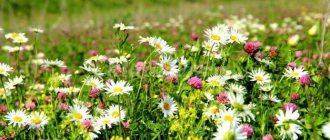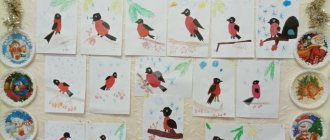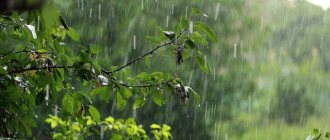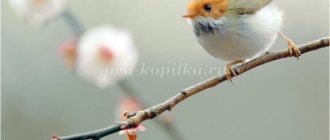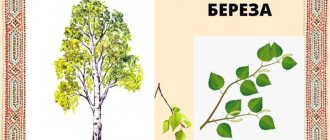Summary of an open integrated lesson in the senior group. Lesson topic: “Forest is our wealth”
Summary of an open integrated lesson in the senior group.
Lesson topic: “Forest is our wealth”
Target:
To clarify and consolidate children’s knowledge about the importance of forests in the lives of humans and animals, to cultivate curiosity.
Tasks
:
Main educational area. Cognition:
consolidate children's knowledge about trees, develop environmental thinking and ecological culture, cultivate interest in plants.
Objectives of integrated educational areas. Socialization:
develop children’s ability to listen to each other, the ability to maintain friendly relationships with peers.
Communication:
continue to expand and develop the child’s dialogical speech.
Health:
continue to develop children's activity in games.
Expected outcome:
Children can name the structure of a tree.
Children can talk about the importance of the forest for humans, and how a person can preserve the forest. Types of activities:
communicative, motor, gaming, artistic creativity.
Forms of organizing joint activities:
didactic games, sedentary active games with rules, conversation, discussion.
Preliminary work:
reading literature about the forest;
observation on walks; solving riddles; looking at illustrations about the plant world, watching video cartoons about nature, making collages. Material for GCD:
illustrations depicting a forest;
model of a tree, leaves of birch, pine, oak; hoops (red and green); prohibiting and permitting signs; easel. Methods and techniques:
verbal - didactic games of an environmental orientation, practical - sedentary games, visual - illustrations depicting various trees.
GCD structure:
- Introductory part:
Invented by someone Simple and wise When meeting, say hello! - Good morning!
Guys, I want everyone to be in a good mood, good morning and good afternoon. We will send our warmth, our good mood, with an air kiss to each other and to our guests.
Today, guys, I invite you to go on an exciting journey into the forest. You will all become young nature connoisseurs. Sit on the carpet and close your eyes, and I will take you to this corner. (Audio recording “Sounds of the Forest”).
II . Main part:
1. Riddle
about the forest.
Working with a tree model (tree structure) 2. Game
“What is a tree for?”
3.
What trees do you know?
(maple, birch, spruce, pine, oak) 4.
How does birch differ from other trees?
(scientific) 5.
What types of forests are there?
(deciduous, coniferous, mixed) 6. Physical exercise “Walk”
7.
Didactic
exercise: “Collect a picture” (flowers)
8. Game
“The birds have flown”
9. Didactic game
“Identify whose footprint.”
10.
Sedentary d/i “It’s possible - it’s not”
(children put prohibition signs in a red hoop, and permissive signs in a green hoop).
- Final part:
Guys, today we talked about the forest. The earth is a common wonderful home for all people, birds, fish, insects, plants. We must take care of our planet and the nature of the Earth so that the air, water, plants grow, and animals do not die. To do this, we all must take care and protect our nature.
Reflection:
Let's all stand in a circle together. And now we will smile, hold hands tightly,
and at parting we will give each other a promise:
WE WILL BE FRIENDS WITH THE FOREST, PROTECT IT, LOVE IT!
You are awarded medals “Connoisseurs of Nature”»
(each child receives a medal)
GCD move:
Educator:
Invented by someone Simple and wise When meeting, say hello! - Good morning!
Guys, I want everyone to be in a good mood, good morning and good afternoon. We will send our warmth, our good mood, with an air kiss to each other and to our guests.
Today, guys, I invite you to go on an exciting journey into the forest. You will all become young nature connoisseurs. Sit on the carpet and close your eyes, and I will take you to this corner. (Audio recording “Sounds of the Forest”).
Slide 2 Teacher:
Here we are in the forest.
And so, little experts, start by guessing the riddle. In the spring it cheers, in the summer it cools, in the autumn it nourishes, in the winter it warms. What is this? Children:
Tree.
Educator:
- Absolutely right, this tree.
—What do you think, is the tree alive or not? Children:
alive.
Educator:
why do you think so?
Children:
because, like all living beings, they eat, sleep, reproduce and breathe.
Educator:
how do trees breathe? (children's answers). - That's right, with the help of leaves. - Guys, how many of you know what parts a tree consists of?
Game "Parts of a tree"
(suitable for the tree model).
Guys, what is this? Children:
tree model.
Educator:
What parts does a tree consist of?
(children's answers). – Vasilisa, tell us about the roots. - Roots, what are they doing? - Absorb water and nutrients from the soil. — The roots hold the tree. - Ilya, tell us about the trunk. -What function does the trunk perform? — Water and nutrients flow through the trunk and branches to the leaves. - Egor Zh., what is on the branches? - there are leaves, flowers, fruits. -Guys, what do leaves release? - oxygen, but absorb light - fruits fall, seeds, falling into the ground, germinate. -When the leaves fall, what happens is they rot, forming nutrients for the tree. - Well done. Educator:
I suggest you play the game “What is a tree for?”
– in this game you need to talk about the meaning of the tree. -Children's answers: - this is a dining room
for animals, insects, birds, since the leaves of trees feed on: elk, birds, caterpillars and other inhabitants of the forest;
- this is a place to build a nest
;
for a beetle, this is a home where prey can be found, a place for laying larvae; - for the hare it is food, bark in winter, shelter; - for an artist it is an object for paintings; - for a tired traveler this spreading tree can hide from the hot sun
and rest;
- a tree for a city dweller is clean air
, coolness in hot weather, a place of rest). - Well done.
Slide 3 Teacher:
— Guys, look at the screen, what do you see?
Children:
trees.
Educator:
what trees do you know?
Name them. Children:
birch, oak, maple, spruce, pine.
Educator:
- How are trees similar
to each other
?
- How are they different from each other? Children
: All trees have roots, trunks, branches.
Some of them have leaves growing on their branches - these are deciduous trees. Those trees whose branches are covered with needles (needles) are called conifers. Educator: Slide 4
- What will be the name of the forest in which coniferous trees grow?
– coniferous. Slide 5
- What will be the name of the forest in which deciduous trees grow?
– deciduous. Slide 6
- What will be the name of the forest in which deciduous and coniferous trees grow?
Children:
Mixed.
Educator:
what is the difference between birch and other trees?
Children:
the color of the trunk.
Educator:
That’s right, the birch tree has a white trunk, it is also called white-trunked. The cortex cells contain a white substance similar to tooth powder. This powder has a beautiful name: betulin. Betulin covers the bark of birch trees with a thin layer. There are elongated dark horizontal stripes on top of the white trunk. These are lentils. They peel off easily because they are made of cork. Through the loose tissue of the lentils, oxygen necessary for the tree to breathe enters the trunk.
Physical exercise “Walk”.
The children walked through the forest,
walking in place.
Nature was observed.
Turn your head left and right.
Look up at the sun,
stand on your toes.
And their rays warmed them.
We have miracles in the world, Sit down, hands on your belt.
The children became dwarfs.
And then everyone stood up together, stand on their toes, hands on their belts.
We have become giants.
Butterflies were flying, running in place, smoothly waving our arms.
They flapped their wings.
Let's clap together, clap our hands.
We stomp our feet.
The floods are in place.
We had a good walk.
The children sit down in their places.
And not at all tired.
But not only trees grow in the forest, but also herbs and flowers. And you will find out which ones by collecting these pictures.
Didactic exercise: “Collect a picture” :
Bluebell, dandelion, carnation, chamomile, forest violet, lily of the valley, forget-me-not, clover. Educator:
How to call it in one word?
Children:
Flowers.
Educator:
Guys, the forest is a house in which not only plants live, but also animals and birds.
Educator:
I invite the guys to play a little.
The game is called "The Birds Have Arrived"
.
If I pronounce the names of birds, we wave our hands like birds with their wings. If I name something else, clap your hands. Children
go out onto the carpet and play
“The Birds Have Arrived”
.
Birds arrived: pigeons, tits, flies and swifts...
Birds arrived: pigeons, tits, storks, crows, jackdaws, macaroni...
Birds arrived: pigeons, martens...
Birds arrived: pigeons, tits, Lapwings, siskins, jackdaws and starlings, Mosquitoes, cuckoos... Birds arrived: pigeons, tits, Woodpeckers and swifts, crows, rooks, Storks, cuckoos, even scops owls. Swans and ducks - and thanks for the joke!
Educator:
- Oh, look at any traces here?
Children:
animal tracks. The didactic game “Identify whose trace” is being played.
Educator:
- How should you behave in such a beautiful forest?
— What can’t be done to preserve such forest wealth? A sedentary d/i “It is possible - it is not”
(children put prohibition signs in a red hoop, and permissive signs in a green hoop).
Probable answers from children:
(Break branches, tumble in the grass, make a fire, admire the beauty of nature, pick flowers, pick mushrooms, destroy nests, destroy poisonous mushrooms, pick berries, leave garbage behind) - Let us check if you have laid out the signs correctly? - Well done!
Slide 7 Teacher:
Do you guys know that some people don’t know how to be friends with nature? They leave unextinguished fires in the forest, cut down forests, and pollute the lakes that feed it with moisture. More than 100 species of different animals and birds were destroyed by people. Many plants have also disappeared due to deforestation, construction of roads, cities, plowing of land and grazing of animals.
Slide 8
In this regard, on March 21
the International Day of Forests
or World Forest Protection Day is celebrated all over the world. The main task of the International Day of Forests is to attract the attention of the inhabitants of the planet to the problem of forest conservation, inform about the importance of forest ecosystems, their true condition, basic measures for their protection and restoration .
Educator:
Guys, today we talked about the forest. The earth is a common wonderful home for all people, birds, fish, insects, plants. We must take care of our planet and the nature of the Earth so that the air, water, plants grow, and animals do not die. To do this, we all must take care and protect our nature.
Reflection:
Let's all stand in a circle together. And now we will smile, hold hands tightly,
and at parting we will give each other a promise:
WE WILL BE FRIENDS WITH THE FOREST, PROTECT IT, LOVE IT!
You are awarded medals “Connoisseurs of Nature”»
(each child receives a medal)
